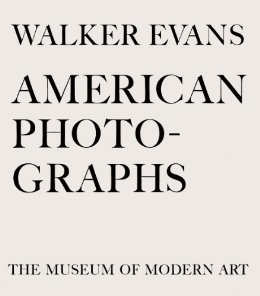American Photographs
Walker Evans. Seventy-Fifth Anniversary Edition. The Museum of Modern Art, 2012. 208 pages. $35.00.
By Svetlana Alpers
This year marks the seventy-fifth anniversary of the Museum of Modern Art exhibition of Walker Evans and the publication of the book of his photographs titled Walker Evans American Photographs.
MoMA commemorated this by hanging a selection of photos from the original exhibition (in 1938 it was located off site at the lower level concourse of Rockefeller Center) in a room in the midst of the painting galleries. The point of hanging them there was to show the connection between Evans and other arts in America. Breaking down the distinction between artistic mediums (and so between different departments at the museum) is a MoMA mission these days. It doesn’t serve Evans well. It is true that the signage in his photos turns up in Pop Art. But the real interest of Evans’ extraordinary photographs is found in the way they see the world, and, in particular, see America, and in the work of the photographers—both American and also European—whose work would not look the way it does without his.
The book is the great legacy. This is its fifth edition. The printing history is set forth in an after note by Sarah Hermanson Meister. The use of new digital files has made the images better. If you do not own an edition of the book, don’t miss the chance to get this one.
Evans had started off as a man of the book: he had seriously tried his hand at writing; he was a reader; writers were close friends. But what strikes one looking through the sequence of photographs is not the relationship of his subjects to themes in American literature, though that has been argued, but the formal relationship it offers to the way we attend to reading a book. There were models for the photobook. There is a relationship between Evans’ “ People by Photography” in the first section of the book and August Sander’s portrayals of German professionals (1930) and between “the indigenous expression” of objects and building in the second section and Eugène Atget’s portrayal of Paris (1927)
But in Evans’ book there is a necessity to each photo and to the composed relationship of each one to the others that is singular. The photographs are printed on the right hand page, a page number appears lower left on the opposite page. Brief titles and dates can be found, like an index, at the end of each of the two sections. The earliest date is 1929, and the latest were made in 1936. There is a stark beauty about the photographs that is matched by the style of the book.
Lincoln Kirstein, whose friendship and wealth enabled the project, wrote an afterword:
“The most characteristic single feature of Evans’ work is its purity, or even its puritanism. It is ‘straight photography’ not only in technique, but in the rigorous directness of its way of looking.”
What Kirstein describes as its purity, but also as its puritanism seems a truth not only about the style of Evans’ work, but also about the art and craft of photography and the American culture to which it is so well suited.
Photographs necessarily exist in the past tense. But Evans’ lyric documentary style, as he named it, looks to be very much of the present: his America of seventy-five years ago bears witness to our own.
Here is a final word from Lincoln Kirstein on Evans’ American Photographs:
“Here are the records of the age before an imminent collapse. His pictures exist to testify to the symptoms of waste and selfishness that caused the ruin and to salvage what was splendid for the future reference of the survivors.”
Svetlana Alpers, an artist, critic and renowned art historian, is professor emerita of the history of art at the University of California, Berkeley and a visiting scholar in the Department of Fine Arts at New York University.
